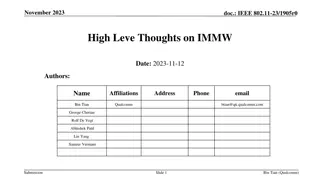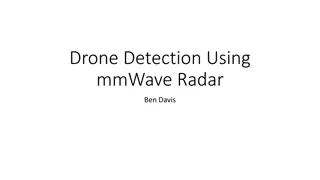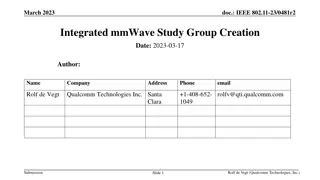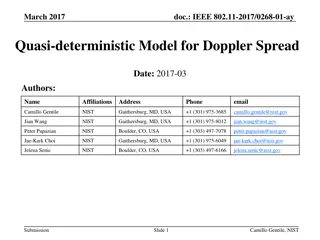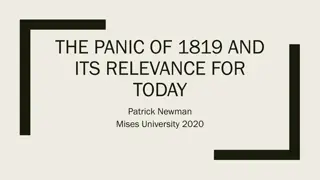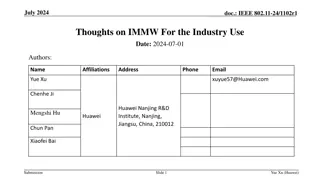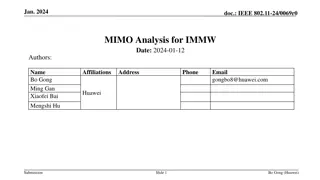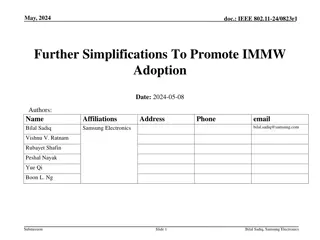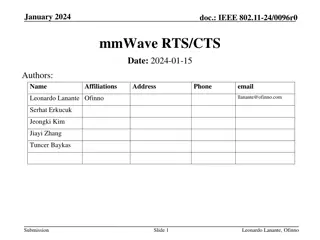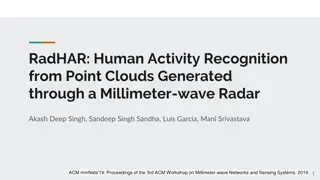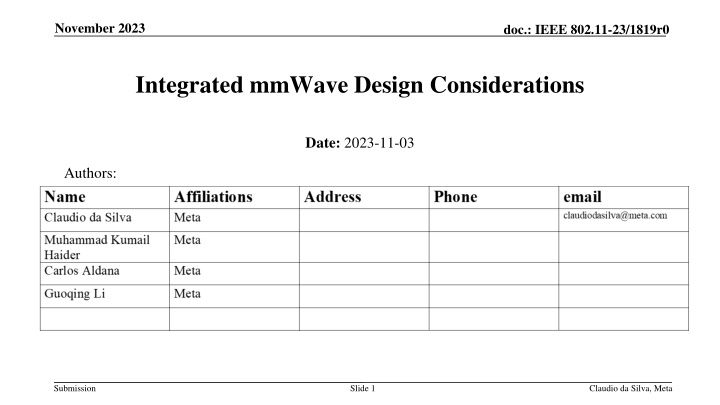
Integrated mmWave Design Considerations for IEEE 802.11-23
Explore the November 2023 documentation outlining the design considerations for integrating mmWave technology within IEEE 802.11-23 standards. The focus is on enhancing Wi-Fi network capacity, throughput, and system reliability by leveraging both sub-7 GHz and mmWave bands. Recommendations include incorporating mmWave into the MLO architecture while minimizing complexity and power consumption.
Download Presentation

Please find below an Image/Link to download the presentation.
The content on the website is provided AS IS for your information and personal use only. It may not be sold, licensed, or shared on other websites without obtaining consent from the author. If you encounter any issues during the download, it is possible that the publisher has removed the file from their server.
You are allowed to download the files provided on this website for personal or commercial use, subject to the condition that they are used lawfully. All files are the property of their respective owners.
The content on the website is provided AS IS for your information and personal use only. It may not be sold, licensed, or shared on other websites without obtaining consent from the author.
E N D
Presentation Transcript
November 2023 doc.: IEEE 802.11-23/1819r0 Integrated mmWave Design Considerations Date: 2023-11-03 Authors: Submission Slide 1 Claudio da Silva, Meta
November 2023 doc.: IEEE 802.11-23/1819r0 Motivation The scope of the IMMW SG, as defined in [1] and [2], is to develop a PAR and a CSD for a new 802.11 MAC/PHY amendment which specifies carrier frequency operation between 42.5 and 71 GHz and leverages MAC/PHY specifications in the Sub 7 GHz bands. The integrated sub-7 GHz and mmWave approach offers the possibility of: Substantial enhancement in Wi-Fi network capacity, increased throughput, and reduced latency with the opening of new wideband channels that allow for a high degree of spatial reuse Allowing for a single baseband processor support 2.4/5/6/60 GHz communications Easier integration and load balancing between sub-7 GHz and 60 GHz links Enhancing system reliability by mitigating impact of on/off nature of 60 GHz links Submission Slide 2 Claudio da Silva, Meta
November 2023 doc.: IEEE 802.11-23/1819r0 Defining Integrated From UHR SG contributions: Goal to reuse the 2.4/5/6 GHz design in 60 GHz to keep complexity within the bounds of lower band 802.11 [3] 60 GHz interface to mainstream Wi-Fi, reusing as much as possible low band baseband and design [4] reuse existing lower band Wi-Fi solution (Modem/PHY, MAC and SW) and upclock it [4] all devices operating in mmWave shall be MLO-capable and shall have at least one affiliated STA/AP in the lower band in addition to the one in the mmWave band [4] We foresee that a multi-link device with both mmwave and low frequency bands is the future [5] Reusing the baseband and designs of low band as much as possible is a good direction to go [6] standardize multi-link (ML) with bands in sub-7 GHz combined with bands in the 45-72 GHz range [7] We recommend defining integrated mmWave within the IMMW PAR, and limiting the effort s scope, by incorporating the following requirements: 1. mmWave PHY derived from sub-7 GHz PHYs 2. Incorporate mmWave links into the MLO architecture 3. mmWave operation requires an enabled sub-7 GHz link Submission Slide 3 Claudio da Silva, Meta
November 2023 doc.: IEEE 802.11-23/1819r0 IMMW Adoption The success of integrated 802.11 systems depends significantly on the ability to offset the substantial area and complexity of mmWave RF/antenna technology. This can be achieved in part through the implementation of a baseband processor (PHY/MAC) that seamlessly supports both sub-7 GHz and mmWave frequencies, while keeping additional complexity (w.r.t. a sub-7 GHz only processor) at a minimum. To this end, we recommend the following design elements: Design to reduce complexity and power consumption as highest priority Support asymmetric links (that is, STAs may have different antenna array sizes) Push higher complexity to AP, smaller antenna arrays at client Goal should be opening new wideband channels (160, 320, and possibly 640 MHz) and *not* defining a PHY that supports (single-stream) data rates higher than those defined for sub-7 GHz For example, keep maximum rate at approximately from 0.5 to 2 Gbps Define bare minimum set of features and options. Reduce IMMW's scope ruthlessly Example: Single-user operation only Submission Slide 4 Claudio da Silva, Meta
November 2023 doc.: IEEE 802.11-23/1819r0 Incorporating mmWave into MLO Architecture Incorporating mmWave into the MLO architecture is key for the success of integrated mmWave: Integration of sub-7 GHz and mmWave required to reduce connection loss/increase reliability (due to mmWave link blockage, for example) and to power save Load balancing between sub-7 GHz and mmWave to reduce latency and enhance throughput while maintaining reliable connection Use of lower bands to reduce mmWave management overhead (association, BF training support ) Potentially avoid definition of a control PHY (see 11ad/ay) Some challenges associated with incorporating mmWave into the MLO architecture: Sustain seamless connectivity even when one of the links (60 GHz) is susceptible to outages (blockage, beamforming training) TBD Submission Slide 5 Claudio da Silva, Meta
November 2023 doc.: IEEE 802.11-23/1819r0 Other Goals Define a lightweight but robust beamforming procedure Beamforming training adds overhead and increases power consumption. Critical to define a beamforming procedure that is less complex and has lower overhead than those in IEEE 802.11ad/ay ideally with the same or increased robustness level. For example, use assumption of asymmetric links (if/when appropriate). Provide adequate MAC efficiency Technical challenges related to timing (IFS) depending on MLO architecture (EMLSR, for example). MLO design elements (previous slide). Define effective power management protocols Submission Slide 6 Claudio da Silva, Meta
November 2023 doc.: IEEE 802.11-23/1819r0 For Further Consideration PAPR reduction techniques High PAPR of OFDM signals lead to poor energy efficiency. Possible techniques: Filtering, subcarrier assignment literature in the area is vast. Certain techniques/approaches could be implementation-dependent; that is, standard support may not be necessary. Topic for further analysis. At the same time, it is critical to not significantly deviate from sub-7 GHz PHY definitions/structure. Submission Slide 7 Claudio da Silva, Meta
November 2023 doc.: IEEE 802.11-23/1819r0 For Further Consideration Consider supporting sensing and ranging applications Added value to IMMW technology. Evaluation of additional definitions and extra complexity (beyond/building upon 11bf and 11az) required. Facilitate coexistence with 60 GHz radar Submission Slide 8 Claudio da Silva, Meta
November 2023 doc.: IEEE 802.11-23/1819r0 Conclusions The success of integrated 802.11 systems depends significantly on the ability to offset the substantial area and complexity of mmWave RF/antenna technology. This can be achieved in part through the implementation of a baseband processor that seamlessly supports both sub-7 GHz and mmWave frequencies. PHY/MAC complexity leads to larger silicon area and power consumption. It is critical to keep the scope of the project as narrow as possible, and limit the number of features and procedures defined in the future IMMW specification. Define integrated mmWave with the following requirements (1) mmWave PHY derived closely from 11ax/be/bn; (2) Integrate mmWave links into the MLO architecture; and (3) mmWave operation requires a 2.4/5/6 GHz connection. Submission Slide 9 Claudio da Silva, Meta
November 2023 doc.: IEEE 802.11-23/1819r0 References [1] 23/0481r2, Integrated mmWave Study Group Creation , March 2023. [2] 23/0188r6, 802.11 March 2023 WG Motions , March 2023. [3] 22/0729r1, "802.11 GEN8 Study Group", May 2022. [4] 22/1595r1, "Some questions to answer in the SG , Sept. 2022. [5] 23/1083r1, "Next Generation SG formation", Jul. 2022. [6] 23/0066r2, "Thoughts on Utilizing mmWave", March 2023. [7] 22/1865r1, "Considerations on the PHY for 60 GHz", Nov. 2022. Submission Slide 10 Claudio da Silva, Meta


